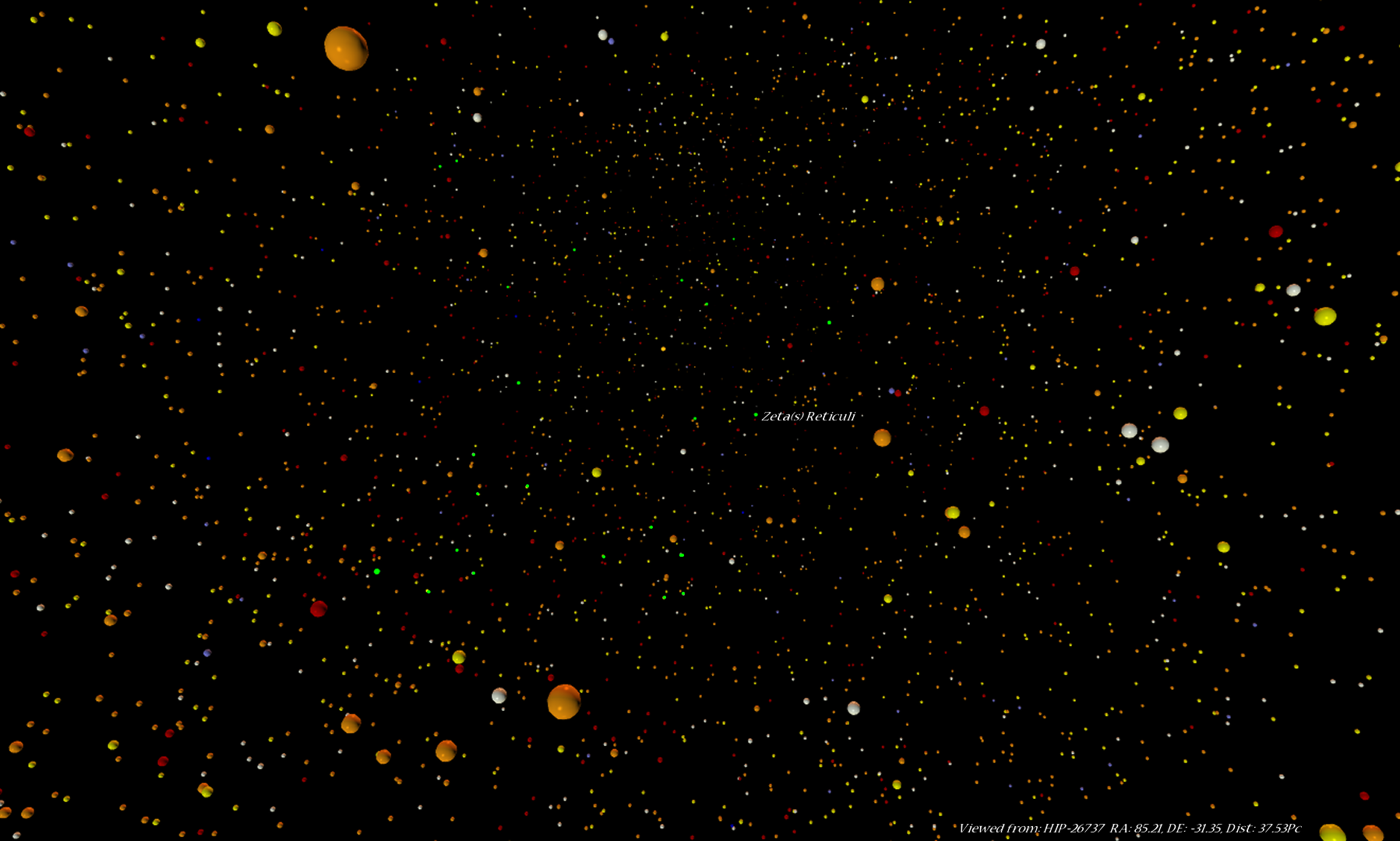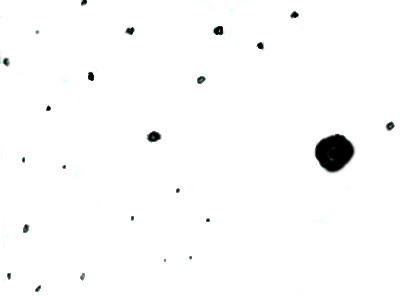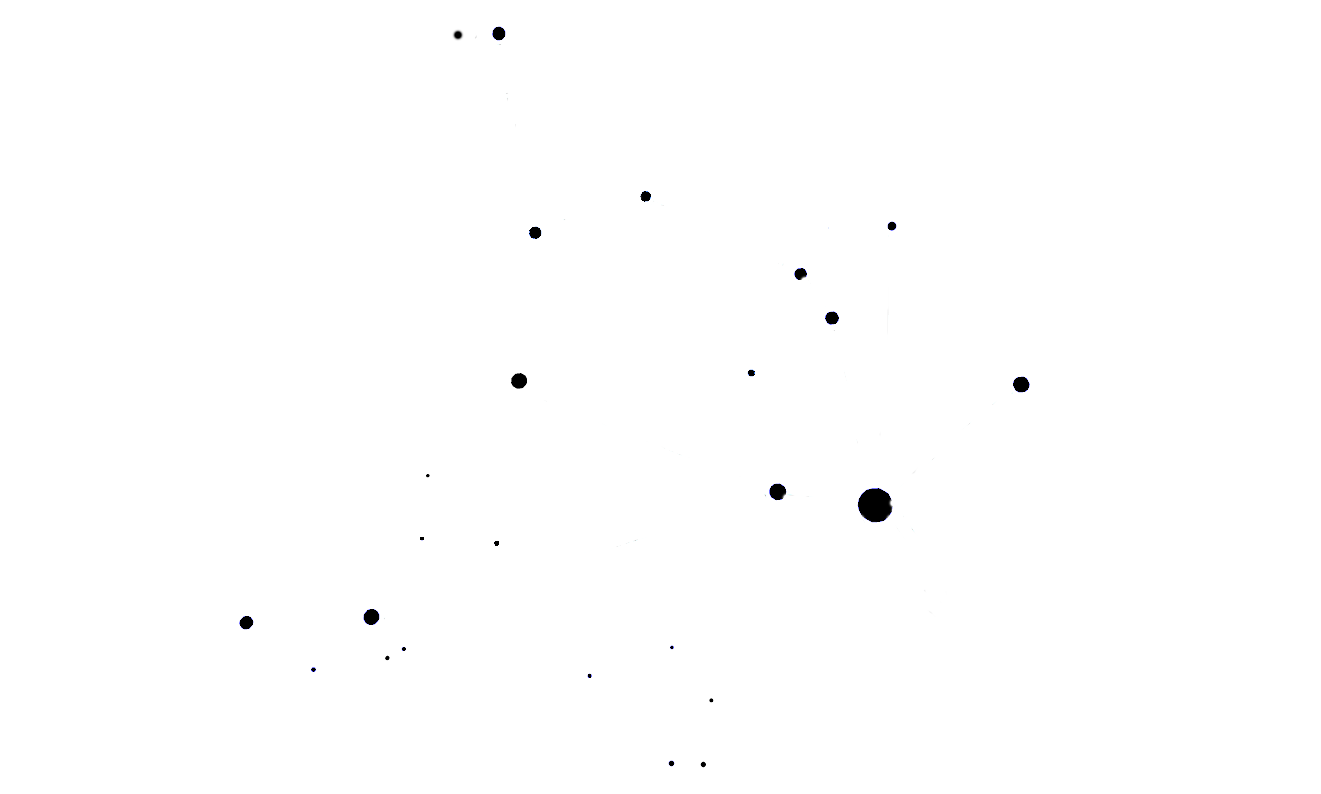It looks like you're using an Ad Blocker.
Please white-list or disable AboveTopSecret.com in your ad-blocking tool.
Thank you.
Some features of ATS will be disabled while you continue to use an ad-blocker.
share:
originally posted by: ArMaP
a reply to: james1947
You put a lot of effort on your work.
Did you use any way of confirming your results?
This process is more of an algorithm to me than anything else, so I see it as a rather mechanical process, end-to-end.
I suppose, IF someone wanted to try to duplicate the experiment, that might go a ways toward Confirming" my work...that, however, is not something I can do.
Do you have any suggestions on how to confirm these result?
a reply to: james1947
Some years ago I tried to find a match for the map using, if I'm not mistaken, "Celestia", a program that allows us to look at the stars and planets from a list of different stars. I suppose a program like that could be used to try to find a match with the map from several different points of view.
Some years ago I tried to find a match for the map using, if I'm not mistaken, "Celestia", a program that allows us to look at the stars and planets from a list of different stars. I suppose a program like that could be used to try to find a match with the map from several different points of view.
originally posted by: ArMaP
a reply to: james1947
Some years ago I tried to find a match for the map using, if I'm not mistaken, "Celestia", a program that allows us to look at the stars and planets from a list of different stars. I suppose a program like that could be used to try to find a match with the map from several different points of view.
When I started this project I looked at Celestia. I needed something that could create a 3D space with the requisite stars. However, Celestia wouldn't work the way I wanted, so, since I already had SmithMicro's "Poser" system I decided to use that instead.
This gave me a fully "browse-able" 3D space with any collection of stars that I desired. This is a little better, and a little harder to use than Celestia, but is essentially the same.
I've modeled Hipparcos stars within 33 parsec, and 43 parsec with the accuracy of the Hipparcos Satellite.
And, I have modeled those stars from other points of view...I should see if I can dig them up.
a reply to: james1947
Hi,
I am making no comment regarding the possible validity of the star map and/or their alleged abduction, but their 3D map was definitely matched to a star system in a UFO documentary I have watched.
I am just commenting as I am wondering if you have seen it and why you would put so much work into something that has already been done by someone else ?
...I am not saying your work is bad or wrong, just hoping you haven't spent heaps of time on something that has already been completed by another person or group.
I'll try and remember / find where I saw the video with the map work in it, but regardless - you've clearly invested a good chunk of time and work to try and find a match for their map.
This isn't the documentary I watched, but it is the same result - although the narrator has a cheesy voice. The result's the same anyway:
Hi,
I am making no comment regarding the possible validity of the star map and/or their alleged abduction, but their 3D map was definitely matched to a star system in a UFO documentary I have watched.
I am just commenting as I am wondering if you have seen it and why you would put so much work into something that has already been done by someone else ?
...I am not saying your work is bad or wrong, just hoping you haven't spent heaps of time on something that has already been completed by another person or group.
I'll try and remember / find where I saw the video with the map work in it, but regardless - you've clearly invested a good chunk of time and work to try and find a match for their map.
This isn't the documentary I watched, but it is the same result - although the narrator has a cheesy voice. The result's the same anyway:
edit on 26-2-2019 by muzj03 because: added video url
originally posted by: manuelram16
a reply to: Phage
Most probable they would use an advanced quantum computer navigation system, but Betty Hill drew a 2d star map....
Dimension often falls pray to convenience. Consider this image:

It is another view on Betty's stars that started life as a 3D image...to show it here, and most other places, it had to become a 2D "snapshot"...unfortunate, but, necessary. Probably for ET as well since a thin 2D displays take up much less real estate.
originally posted by: muzj03
a reply to: james1947
Hi,
I am making no comment regarding the possible validity of the star map and/or their alleged abduction, but their 3D map was definitely matched to a star system in a UFO documentary I have watched.
I am just commenting as I am wondering if you have seen it and why you would put so much work into something that has already been done by someone else ?
...I am not saying your work is bad or wrong, just hoping you haven't spent heaps of time on something that has already been completed by another person or group.
I'll try and remember / find where I saw the video with the map work in it, but regardless - you've clearly invested a good chunk of time and work to try and find a match for their map.
No, I don't think I've seen the documentary, but, I doubt they did their analysis quite like mine.
And, I'm a retired Software Engineer (Computer Scientist), I have plenty of time and need things to keep my mind working. Besides, after all this time; it's still fun!
a reply to: james1947
It is funny when you look at astronomical topics and find astronomical odds. I'd like to see the number of astronomers who will state they believe the Betty Hill case was legitimate contact or a psychological phenomenon.
Your odds seem undeniable, yet I don't feel convinced. I've had similar findings with remarkable odds. I found no support from those specific groups of people. For a long time, I was convinced that FRB121102 was assuredly an artificial signal. Since CHIME found a second repeating FRB, I threw my idea away. If I had your level of optimism, I'd probably still be decoding it.
It is funny when you look at astronomical topics and find astronomical odds. I'd like to see the number of astronomers who will state they believe the Betty Hill case was legitimate contact or a psychological phenomenon.
Your odds seem undeniable, yet I don't feel convinced. I've had similar findings with remarkable odds. I found no support from those specific groups of people. For a long time, I was convinced that FRB121102 was assuredly an artificial signal. Since CHIME found a second repeating FRB, I threw my idea away. If I had your level of optimism, I'd probably still be decoding it.
if you allow a " margin of error " and examine a large enough dataset - you will match " somehing "
originally posted by: ziplock9000
While it may be true that with a large enough dataset a match will be found...
We are only working with a very limited dataset of 2826 stars.
That is the number of Hipparcos stars found within 33 parsec from Earth. This limit was chosen because:
1. These visitors are supposedly from Zeta Reticuli, a Binary Star some 39+ light years, or about 12.26 parsec
2. Space is a vast place with distances between stars and planets equally vast, the radius was kept small because we don't know how viable the "warp drive" really is, so travel is difficult at its very best.
3. Any visitors we encounter will logically be from near by stars, mainly due to difficulties in travel.
So while it may work with enough stars, we quite simply don't have the luxury of having an extensive dataset; as I stated about 2826 stars.
Then there is the mathematical fact that IF we increase the number of stars the probability of finding a good match decreases.
originally posted by: ignorant_ape
if you allow a " margin of error " and examine a large enough dataset - you will match " somehing "
While it may be true that with a large enough dataset a match will be found...
We are only working with a very limited dataset of 2826 stars.
That is the number of Hipparcos stars found within 33 parsec from Earth. This limit was chosen because:
1. These visitors are supposedly from Zeta Reticuli, a Binary Star some 39+ light years, or about 12.26 parsec
2. Space is a vast place with distances between stars and planets equally vast, the radius was kept small because we don't know how viable the "warp drive" really is, so travel is difficult at its very best.
3. Any visitors we encounter will logically be from near by stars, mainly due to difficulties in travel.
So while it may work with enough stars, we quite simply don't have the luxury of having an extensive dataset; as I stated about 2826 stars.
Then there is the mathematical fact that IF we increase the number of stars the probability of finding a good match decreases.
originally posted by: Archivalist
a reply to: james1947
It is funny when you look at astronomical topics and find astronomical odds. I'd like to see the number of astronomers who will state they believe the Betty Hill case was legitimate contact or a psychological phenomenon.
The two most common misconceptions about this is that;
1. it can be psychological in nature. However, Betty's map kind of removes that from consideration because psychology cannot affect the map as we know it today, nor can it affect the placement and nature of the stars we find ourselves residing in...those things are kind of fixed.
2. Coincidence. Many would like to believe this, but, again, mathematics kind of removes that from the overall equation...those astronomical "odds".
Although, I would like to see other "things" that might be at play here.
Your odds seem undeniable, yet I don't feel convinced. I've had similar findings with remarkable odds. I found no support from those specific groups of people. For a long time, I was convinced that FRB121102 was assuredly an artificial signal. Since CHIME found a second repeating FRB, I threw my idea away. If I had your level of optimism, I'd probably still be decoding it.
Well I don't see anything as "optimism" here. What I see is a rather straightforward process that indicates with great assurance that everything I see in this analysis is accurate and correct...kind of like optimism giving away to scientific precision.
originally posted by: manuelram16
a reply to: james1947
I actually been using Google Sky to learn some basic star positions but would like a 3d environment,
checked "Celestia" & "Poser" could you elaborate more on your experience with them?
Sure...
Celestia: is a true astronomy application. It has builtin several star (astronomical) catalogs that allow you to find stars and other things by their common name, or the scientific nomenclature. Celestia will allow you to position yourself on any astronomical; body and literally "look around", you can look in 360 X 360 degrees, and you can zoom in or out.
If you want to investigate stars, or simply look at them Celestia is the better choice. Celestia is free.
Poser: is a 3D character animation and rendering system that is low cost (about $500), and reasonable robust. It will allow you to build 3D "constructs" (whether that be a person, thing, or stars), animate them, and/or render them as a high quality image.
If you want to investigate "stars" with poser yo will need to learn to program in Python (to import / construct star system accurately). Python is an "easy" language. Then of course yo will need something like Hipparcos, to know where to put stars.
All-in-all, trying to do something like that with Poser is rather difficult. I get away with it because I've been a software for 45 years, to the requirements of creating "code" and data doesn't faze me much...
I think in you instance; I'd stick with Google Sky and Celestia, they will take you a very long way...and you'll have fun too.
a reply to: james1947
Celestia is good though if you know Python and want good 3D models/renders use Blender. It's open source and besides the horrid UI which hasn't been changed since day one practically -_- it out does Poser 11 Pro in every aspect. Poser is mainly for animating human models and basic 3D primitive models and the render engine in 11 Pro is dated. Been using Poser since Bryce/Corel owned it before Sun Smith bought it from DAZ. Also interesting thing is a few years ago a person made a map based off the Betty Hill map in Poser and even in Poser 14 it was...bad even with the "new render engine" in 14 Pro. Would be interesting to see the 3D map imported to Blender. Good work though.
Celestia is good though if you know Python and want good 3D models/renders use Blender. It's open source and besides the horrid UI which hasn't been changed since day one practically -_- it out does Poser 11 Pro in every aspect. Poser is mainly for animating human models and basic 3D primitive models and the render engine in 11 Pro is dated. Been using Poser since Bryce/Corel owned it before Sun Smith bought it from DAZ. Also interesting thing is a few years ago a person made a map based off the Betty Hill map in Poser and even in Poser 14 it was...bad even with the "new render engine" in 14 Pro. Would be interesting to see the 3D map imported to Blender. Good work though.
originally posted by: Archivalist
Your experiment is incomplete.
If you want this to be convincing you need a standard population and probability control.
You need to have people attempt to draw star maps, randomly.
Then try to match those "star maps" and see if you can get matches with any reasonable probability that approaches the Betty Hill percentage.
If random population sample pulls are not even close,then your argument is convincing.
Until you do that, this is just a neat idea.
The aliens enhanced/implanted memories to allow her to, as accurately as necessary, recall the map.
I guess you don't read much about reported alien encounters. They can do stuff...
originally posted by: Arbitrageur
Those two images don't look that much alike to me. I think you are biased to want to believe in the Betty Hill star map.
originally posted by: james1947
Betty's map cleaned up
My map...
I was also wondering, what are we supposed to be seeing here?
new topics
-
Chris Cuomo, who pushed vaccine shots on CNN, admits Moderna vaccine destroyed his health
Mainstream News: 1 hours ago -
History Shows; Many Crisis Are Artificial I'm Order To Enslave People
Political Conspiracies: 1 hours ago -
StormyD Accused of Falsification of Business Records to Hide Money From Trump
US Political Madness: 11 hours ago
top topics
-
Judge Postpones Trump Classified Docs Trial INDEFINITELY
US Political Madness: 14 hours ago, 33 flags -
StormyD Accused of Falsification of Business Records to Hide Money From Trump
US Political Madness: 11 hours ago, 21 flags -
To all ATS members of Faith - Prayer request
Religion, Faith, And Theology: 17 hours ago, 13 flags -
Chris Cuomo, who pushed vaccine shots on CNN, admits Moderna vaccine destroyed his health
Mainstream News: 1 hours ago, 3 flags -
History Shows; Many Crisis Are Artificial I'm Order To Enslave People
Political Conspiracies: 1 hours ago, 1 flags
active topics
-
Breaking--Hamas Accepts New Cease Fire
Middle East Issues • 251 • : network dude -
Shocking moment four men 'try to force Jewish pedestrian into car boot' in North London
Breaking Alternative News • 98 • : andy06shake -
Chris Cuomo, who pushed vaccine shots on CNN, admits Moderna vaccine destroyed his health
Mainstream News • 6 • : lincolnriley -
Judge Postpones Trump Classified Docs Trial INDEFINITELY
US Political Madness • 45 • : CarlLaFong -
StormyD Accused of Falsification of Business Records to Hide Money From Trump
US Political Madness • 35 • : network dude -
The Acronym Game .. Pt.3
General Chit Chat • 7810 • : bally001 -
Russia Ukraine Update Thread - part 3
World War Three • 5764 • : gortex -
Russia police launch major manhunt after troops massacred by comrade in occupied Ukraine
Other Current Events • 18 • : andy06shake -
Candidate TRUMP Now Has Crazy Judge JUAN MERCHAN After Him - The Stormy Daniels Hush-Money Case.
Political Conspiracies • 1410 • : Lazy88 -
History Shows; Many Crisis Are Artificial I'm Order To Enslave People
Political Conspiracies • 0 • : ADVISOR


